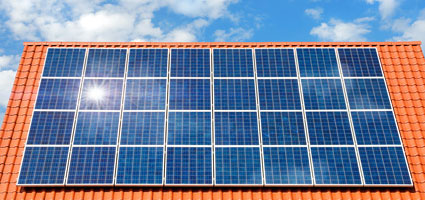Imagine you walk in a shoe store and the shop assistant immediately starts measuring your head with a tape measure. You’d think she was mad, wouldn’t you? And you’d be right, of course. Sometimes the basics are just self-evident.
If you need shoes, all the information you need is right there at the bottom of your legs. Same with solar power. No reason to start anywhere but right up there on your roof.
And there are 3 questions about your roof that you have to answer right away before we move on to anything more advanced. And you’ll soon see why…
Question #1 Which direction does your roof face?
If the only option available to you is to place solar panels on a south, south-east or south-west facing roof, be very careful. Be sure your installer performs a scientific analysis, puts the results in writing and shows it to you before moving forward. It is very unusual for a south facing roof to be suitable for solar!
If your only option is an east or west facing roof, then if you have a choice – go west. It means your electricity will be generated later in the day – which is when most people use more electricity.
I cover everything you need to know about roof direction and solar here.
If you do install on a West or East facing roof, expect to lose about 15% compared to the optimum direction – North.
North facing roofs are obviously best here in Australia, but even with north facing roofs, there are other considerations of even greater importance. Keep reading…
Question #2: What Pitch is Your Roof ?
One of the most common questions I get asked is, “Does the slant or angle of my roof (and therefore the slant of the panels) matter?” And the short answer is “No, as long as your roof isn’t flat.”
Angled panels do perform better than flat panels, but variations in the angle (Australian roofs run from 15 to 22 degrees) make very little difference in energy absorption (usually less than 1%).
However, flat panels absorb as much as 9% less energy than angled panels. Also you need a slight angle (at least 10°) for the rain to run off and clean the surface. So, if you have an absolutely flat roof, and your installer does not suggest angling the panels, run away. Be afraid.
I go into lots more detail about roof angle and solar here.
Question #3: Is Your Roof Shaded?
This is a big one. Nothing destroys the efficiency of a solar system like shade. Not roof pitch, not roof direction, not clouds, not anything.
When it comes to solar power, shade is the devil. Period.
If your roof experiences significant shade from 9am to 3pm, and you’re not willing to chop down those lovely trees, I’m afraid you’re out of luck.
And if an installer tells you any different, you, my friend, are in the presence of a cowboy.
But wait, you say, what about “shade tolerant panels”. No such beast. There are “low light panels” that can pull in more energy in areas that experience weaker sunlight. But these have nothing to do with shade! Beware if your installer starts talking about “shade tolerant” systems.
What if you have shade that is not “substantial”? Keep a look out for a device called a SunEye. And if you don’t see it in your installer’s hand, and you don’t get a report based on the readings from the SunEye, and your installer won’t guarantee the findings in the report….run away.
Read more about what to do if your roof has any shade at all here.
If you are considering solar and you would like 3 independent quotes from the best local installers that know all this stuff backwards (trust me I’m very fussy about which companies I refer!) then you can get 3 great quotes here.


 RSS - Posts
RSS - Posts



My amateur knowledge about shade tolerance goes something like this. Panels conventionally have their circuits in series. Then shading part of such a panel has big effects. If you have your panels separately wired, like Tindo ones which have an inverter on each panel, then you are better off. So shade tolerance might be a factor. And then there is the thin strip technology, which helped that way too, but I don’t know if that got anywhere.
The analogy with shoe shopping is good. The first question is “what kind of shoes are you looking for?”. The answers lie in the consumers head not their feet or roof. The end result if charging straight to the roof will be poor advice and either over investing or under investing. Quality solar installers always invest time in understanding patterns of consumption and educating the customer. As the industry matures it is likely to evolve into the Harvey Norman retail model and competent turnkey contractors. Finn neglected to mention that the sunpathfinder is an older and more accurate version of the suneye. The best strategy for shading is to measure the shading accurately and recommend modules with a higher kW/sq meter performance such as SunPower to get the most out of the available sunshine.
I cannot emphasize on how happy I am with the solar panels that I got in my home. They helped to save a lot on my electricity bill.